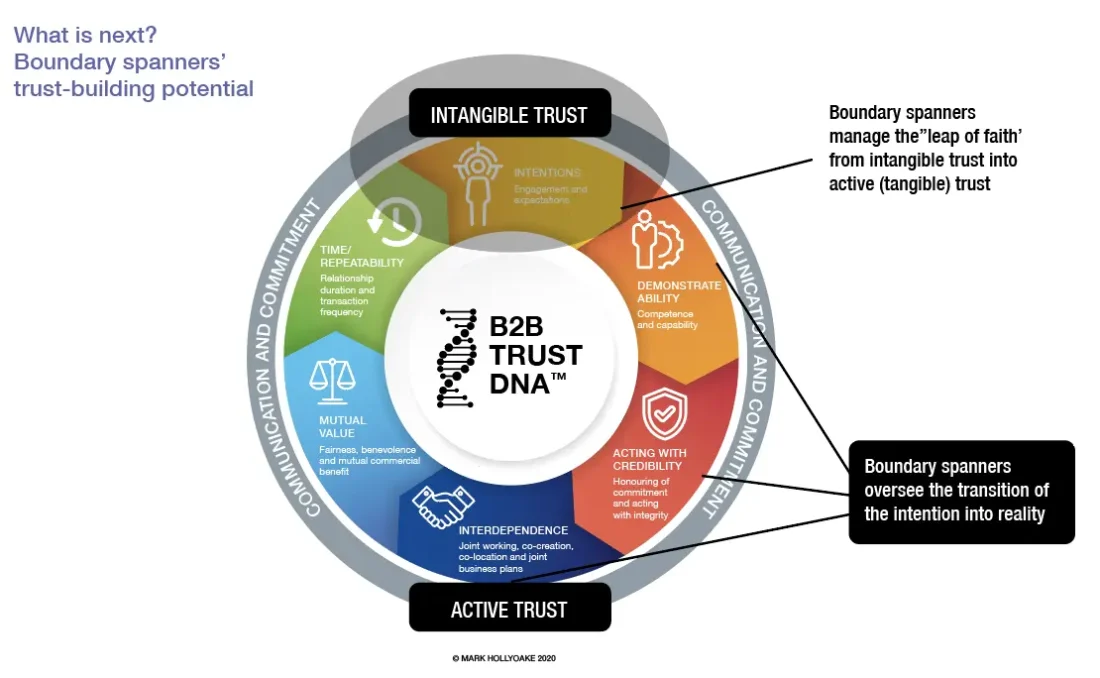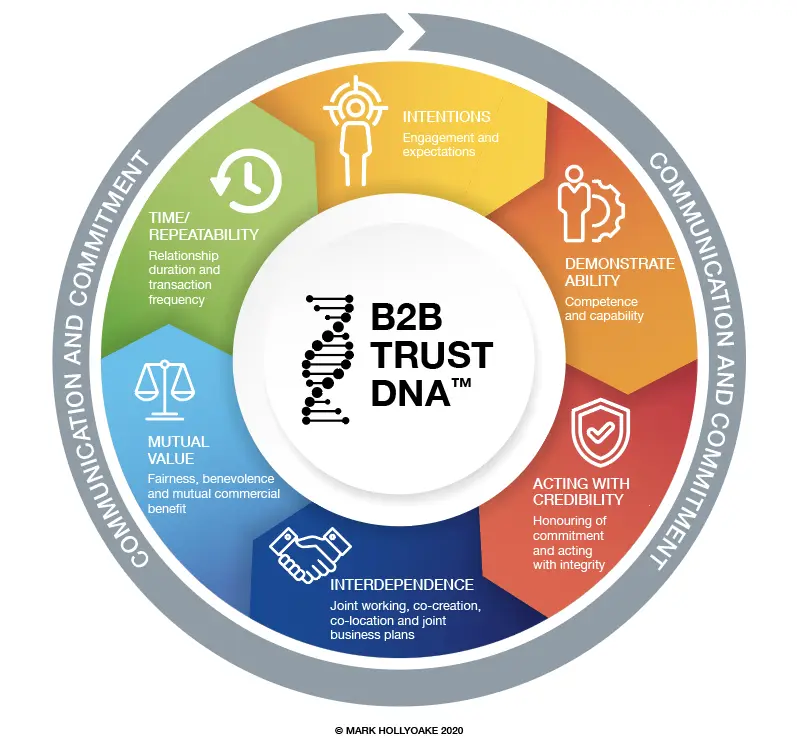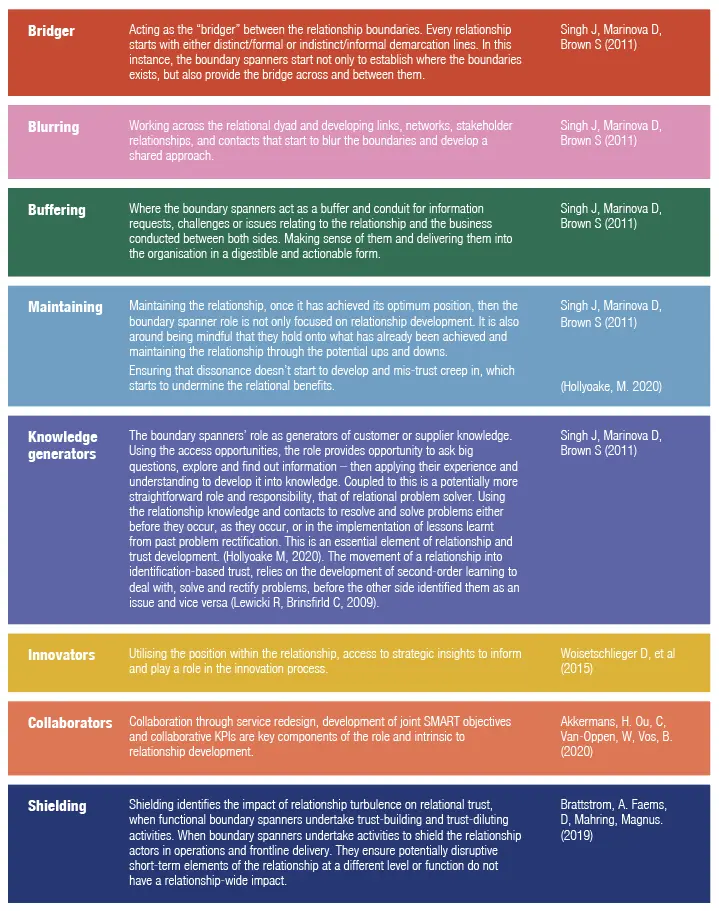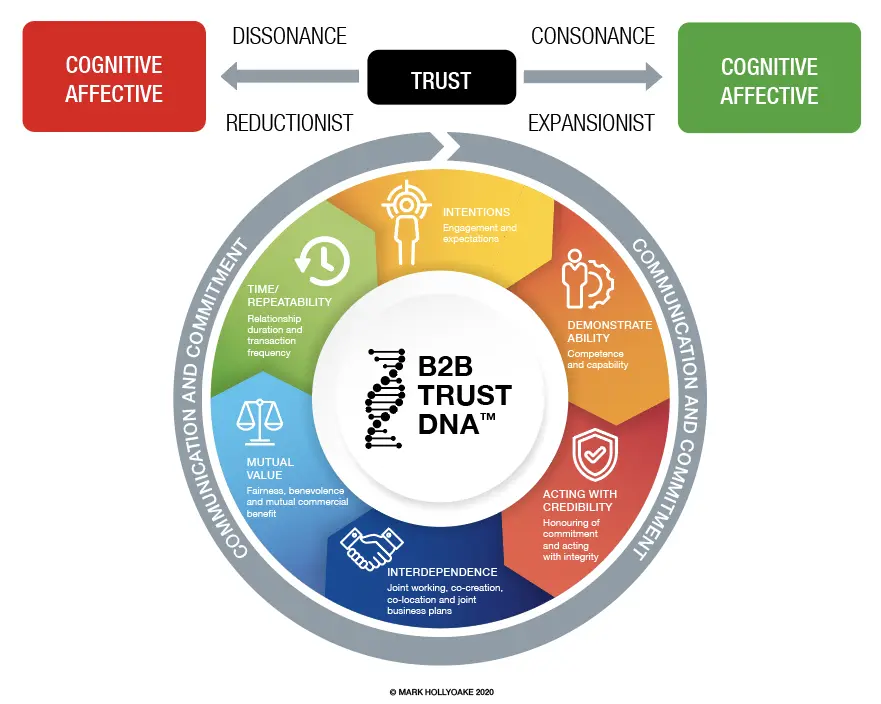Leap of faith
22nd April 2024 | Mark Hollyoake
B2B trust research: what’s next?
Abstract
New academic research on trust will build on insights generated through Mark Hollyoake’s 2020 doctoral thesis (see previous article). They aim to dig deeper into the role of the “Boundary Spanner in relational trust development”, based on eight years of academic research through the University of Southampton.

The original research
Boundary spanners: What are they? What do they do? Why are they important? And what exactly do we mean by a boundary spanner? On a very simple level they are actors on both sides of a relationship that span the boundary between one and the other for relational management or development. According to Möllering (2002), boundary spanners manage the “leap of faith”, responsible for managing and mitigating risk, as is evident in Figure 1.

Relationship boundary spanners have a mitigating effect on the movement from relational intent (intangible) to relational action (tangible), reducing vulnerability, and the magnitude of the “leap of faith” required. This supports the earlier work of Naslund (2012 p23), suggesting that: “Interpretation and expectation are largely based on cognition, while the leap of faith relies more on the affective aspects”.
So, what type of role may typically be considered and understood as boundary spanners? Traditionally, these would be the salesperson, client director, and account manager in the supplier organisation; in the buying organisation, this would typically be the buyer, procurement manager, category buying manager, or supplier manager.
However, the dynamics in B2B relationships have now changed given increased complexity, with the involvement of additional contacts and actors. The roles within category management, customer marketing, trade marketing, supply chain and IT (to name but a few) are now inherently involved in the relationship and could be seen as boundary spanners. The same also holds true for the commercially focused elements of leadership teams, both at Head Office and group level, as they become increasingly involved in B2B relationship development and trust building.
Positive impact
My thesis uncovered the role of the boundary spanners and affective trust as having a positive impact on the move from intangible trust as organisational intention towards activation and into tangible trust. An additional role of the relationship trust developer (boundary spanner) needs to be considered and they make the step (rather than the leap of faith) (Möllering 2002) mitigate the risk and ameliorate the vulnerability.
The boundary spanner role is not simply a set of rules that are followed to the letter (Perrone V, Zaheer A, McEvily 2003). The role is often open to interpretation and frequently subject to multiple, complex and conflicting pressures (Kahn at al 1964). Therefore, we cannot predict the development of trust merely based on the formal role definition, and must look beyond this to understand the subtleties of how roles influence the level of trust that is placed upon them.
In their research into boundary spanners Neal J W, Neal Z, and Brutzman, B (2022) uncovered a number of definitions related to the role of boundary spanner: “We define the practice of boundary spanning as work to enable the exchange between the production and use of knowledge to support evidenceinformed decision-making in a specific context and boundary spanners as individuals or organisations that specifically and actively facilitate this process.” Bednarek et al (2018) define boundary spanning as, “work to enable exchange between the production and use of knowledge to support evidence-informed decision-making in a specific context”, while Posner and Cvitanovic (2019) define boundary spanners as the “individuals or organisations that specifically and actively facilitate this process”.
And here lies the paradox. While the theory seems straightforward, the application is quite different.
The work I initially covered in my doctoral thesis focused on B2B relational trust, offering significant insights into the dynamic nature of trust, how it operates, the impact it has on B2B relationships, and how to proactively develop it in B2B. From this research I developed a B2B trust DNA™ Model (Figure 2).

The model provides a systemic approach to trust building, starting at the intention stage which is intangible trust. It then moves into active trust through the reality of ability, credibility, and the interdependence within the relationship. If applied proactively and positively by both sides, it results in the development of mutual value. Relational commitment and communication act as the oil to the central DNA, enabling them to work effectively in the pursuit of mutual value creation.
However, from working on projects with various organisations over the last 15 years, it’s become increasingly clear that more research is needed into the role of boundary spanners in developing relational trust as they navigate the relationship from intangible trust into tangible trust, (as can be seen in Figure 1.)
What will additional research do?
The extant literature reviewed to date points towards the key responsibilities and activities related to the role of the boundary spanners in two key areas:
- The activities and roles the boundary spanner undertakes as the relationship moves from intangible trust to tangible trust (active) trust (Giddens 1954) as both sides undertake what Möllering (2002) refers to as a “leap of faith”. In this context, and at this point in the relationship’s development, the role is focused on the mitigation of the risk both sides perceive in the move from intention, intangible trust and into the reality, activation of the intention and tangible trust development (Akkermans H, Ou C, Van-Oppen W, and Vos B (2020), as can be seen in the following:
i. Establishing the expectations and engagement frameworks across both sides of the relational dyad (Hollyoake, M. 2020).
ii. The development and demonstration of the expected value opportunities the relationship is expected to create for both sides, and the timeline for that development (Hollyoake M 2020). This could be viewed as the boundary spanner being a mutual value creator. (Akkermans H, Ou C, Van-Oppen W, and Vos B (2020); (Hollyoake M 2020); Akrout H, La Rocca A 2019).
iii. Hayam Alnakhli, Aniefre Eddie Inyang, and Omar S Itani (2021) argue that salespeople need to effectively listen to their customers to provide needed solutions by jointly working with them to co-create value.
iv. Similarly, a salesperson’s communication and adaptive selling skills have collective impacts that positively contribute to the value co-creation process. Results supplement previous findings in the literature by showing value co-creation holds a positive effect on sales performance at the micro salesperson level. The results offer additional support to the ongoing dialogue on the role of a salesperson as value co-creator. Hayam Alnakhli, Aniefre Eddie Inyang, and Omar S Itani (2021) go on to identify several variables that engender successful cocreation by salespeople in B2B sales contexts. Their findings demonstrate that salespeople who can adapt their selling approach are good listeners, and who can effectively communicate with customers, can engender the value cocreation process with customers. The findings serve as a base to create professional guidelines about the skills and capabilities salespeople need to successfully execute a value co-creation process (Hayam Alnakhli, Aniefre Eddie Inyang, and Omar S Itani 2021).
- The development of the intention into a reality as the relationship moves into active trust (Giddens 1954) development (Singh J, Marinova D, and Brown S, 2011) points to a number of boundary-spanning activities undertaken as relationship and trust builders – see Figure 3.
Boundary-spanning activities

To date, there has been significant research into the way boundary spanners work, but the majority of the literature revolves around role diversity, role stress, inter-role behaviour, role stress theory and role behaviour.
The literature also demonstrates how boundary spanners without role clarity can create ambiguity that leads to role stress and early burnout. The boundary spanner can be torn between the needs of their own organisation and the needs/ business drivers of the customer, as due to their unique location in the organisation spanning both sides, they are simultaneously exposed to competing expectations from their own and also from the partner organisation (Khan at al 1964, Strauss 1962, Spekman 1979).
Dissonance and consonance
In essence, in their paper Brattstrom A, Faems D, and Mahring, Magnus (2019) discuss relationship dissonance and consonance in relational trust building triggered through domain and functionally specific activities. The focus is on convergence and divergence: what causes it. This is echoed in a more holistic research approach (Hollyoake M, 2020) that identified trust dissonance and consonance across both cognitive and affective trust, through the application or misapplication of a B2B model for trust development (Figure 4).

From working on projects with various organisations over the last 15 years, it’s become increasingly clear that more research is needed into the role of boundary spanners in developing relational trust as they navigate the relationship from intangible trust into tangible trust.
Exploring dissonance starts to identify some of the pitfalls that boundary spanners could avoid and relational techniques they could deploy to ensure relation trust is maintained and developed. Although, the paper of Brattstrom A, Faems D, and Mahring, Magnus (2019) is not focused on the boundary spanners per se, the activity of shielding could be an effective element of the boundary spanner’s role. Ensuring potentially disruptive short-term elements of the relationship at a different level or function do not have a relationship-wide impact.
It is not unusual to encounter boundary spanners working tactically outside of the required role, despite having clear descriptors developed through a capability and competency framework. The strategic element of the role gets lost among daily firefighting short-term tactical issues. This can be seen when boundary spanners experience role ambiguity on a personal level, the internal organisational level, or externally. The pursuit of firefighting and resolution of short-term issues, as well as challenges in the business and relationship, means taking on this responsibility could be attributed to:
- Justification and role protection – need to be seen to be active within the relationship.
- Covering shortfalls in operations and the organisation’s customer-centric culture.
- Lack of clarity and understanding of what the role encompasses.
- Insufficient role training and development.
- Profile building internally/externally.
Any of these can lead to relational downsides and turbulence, as the short-term focus comes at a cost, reducing relationship management, resilience, and development. Unless addressed over time, the relationship descends into shorttermism, with an erosion of the overall relational intent.
Emerging themes
The literature addresses some aspects related to the role that boundary spanners undertake in managing the migration of the relationship as it moves from intangible to tangible and its ongoing trust development. When we consider the ways that trust develops and how this potentially links to the Trust DNA™ model (Figure 2) several themes start to emerge:
- The activities boundary spanners undertake to mitigate the relationship or perceived risk in moving from intangible to tangible trust, and those involved in making it happen.
- The elements of the boundary-spanner roles (customer and supplier) that are undertaken to develop a trust-based relationship.
- The translation of the relational intent into implementation plans that are briefed, socialised, and agreed by both sides.
- Value opportunity broken out into elements of initial value across the (CHARM) value model, and how value will be realised with an appropriate measurement framework.
- Sharing learnings and knowledge to build ability within the relationship.
- Leading cross-functional joint working, setting the objectives, ways of working and measurement framework.
- Developing and implementing communication plans; the who, the how often, the medium used, style and messaging; the provision of one voice for the relationship across all levels, functions and both sides.
- Demonstrating, monitoring, and creating relationship commitment.
- Agreeing the relationship performance dashboard, monitoring, and sharing relationship development versus plan, re-calibrating where necessary.
Getting involved
All the above, offer significant opportunity to understand the intricacies of the boundary spanner role and how it could be deployed for relationship improvement and trust building. Understanding this can inform capability and competency development, role specifications and development programme for those already in role or in early-career-stage development.
The research I propose represents the next stage in the exploration of relationship trust building. If you would like to know more, or get actively involved as the research enters the field stage, and keep up to date with the insights it generates, please get in touch: mark.hollyoake@uwe.ac.uk
For more information on my original research in developing the Trust DNA Model, click on Research into B2B Trust


